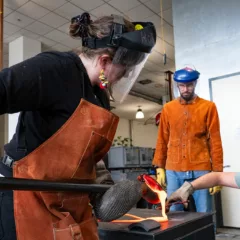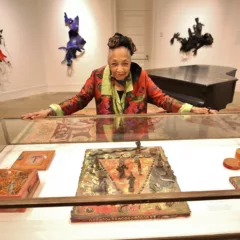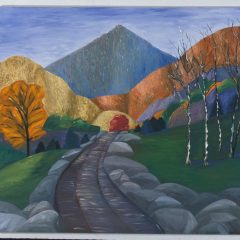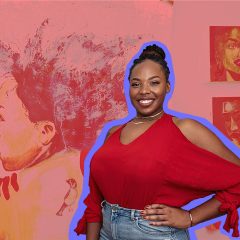The work and legacy of the great Philadelphia-born artist Charles Searles (1937-2004) will be explored in three concurrent exhibitions at LaSalle University Art Museum, Woodmere Art Museum, and Tyler School of Art. The kernel for these exhibitions formed when Kathleen Spicer, Searles’ wife and fellow artist, contacted Temple University’s art history program requesting assistance cataloging and organizing the Searles estate. This eventually led to a series of exhibition seminars, in which undergraduate and graduate students at Tyler School of Art and LaSalle University worked to fulfill Spicer’s request. The result is three different but complementary exhibitions, along with an extensively researched 200-plus page catalogue devoted to Searles’ life and work. For their efforts, the students received funding for the shows from the Knight Art Challenge, an accomplishment which speaks volumes about the power. Searles’ work is staggering in its scope and emotional and visual impact. These exhibitions advance our understanding and appreciation of an artist who explored the figure and abstraction, photography, painting, and sculpture, and a visual language informed by western academic art traditions, music and dance, and the visual and cultural life of Nigeria and Ghana.
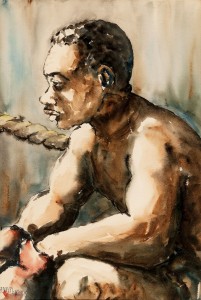
From realism to abstraction, on display at Woodmere
Searles studied at the Pennsylvania Academy of the Fine Arts and his traditional figurative training is evident in the Woodmere’s Charles Searles: A Focus on the Figure, curated by Tyler School of Art Art History Ph.D. candidate Maite Barragan. This small and effective exhibition contains drawings and paintings from the 1960s through the 1980s.
During this time, Searles moves from realistic to flattened, abstracted figures. Searles’ style, “changes so rapidly,” noted Barragan in an email. “In his earlier work he really attempts to recreate figures in a naturalistic manner. He focuses on anatomy and attempts to get every detail correct.”
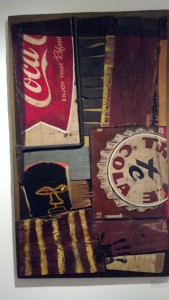
Location as inspiration at LaSalle University Art Museum
Eventually, Searles became frustrated with the traditional teaching modes at PAFA and in 1967 he took a semester leave to work in his South Street studio and develop his own modern style inspired by images and ideas from the streets of Philadelphia. The mixed media painting “Bo Bro Bill,” 1969, in the LaSalle University Art Museum exhibition, exemplifies this period. The mix of Coca-Cola signs and bottle caps are evidence of the urban signage and detritus that Searles collected and then assembled in his work. He also discovered the African art collections at the University of Pennsylvania Museum of Archaeology and Anthropology. These collections impacted Searles’ developing style which at the time included collage, flattened figures, and an interest in African art and aesthetics.
In 1972 Searles’ was awarded PAFA’s Lewis S. Ware Memorial Traveling Scholarship which allowed him to visit Nigeria and Ghana.
Susanna Gold, Assistant Professor of Art History at Tyler School of Art, mentioned in a phone conversation that Searles was one of the first artists to visit Africa during “an early phase of a number of black American artists who traveled to Africa to experience the culture and to engage the culture in their work.” During a lecture on Searles’ work, Spicer noted that this trip was “a life altering experience,” where he realized that “people walk while wearing patterns…they were like walking sculptures.”
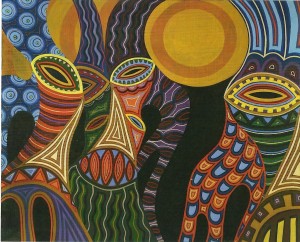
Rhythm, dynamism, and musicality in Searles’ art
Indeed, the brightly painted surfaces in Searles’ works move, dance, and suggest rhythmic surges. His sculptures stretch out against a wall or leap into space. Patterning and movement are abundantly present. Many of his paintings and sculptures are synesthetic, suggesting dance, rhythmic sound, and songs, all communicated with interacting shapes and intense colors. In some works, such as those from the “Soul” series of the mid-1970s, mask-like eyes peer out of patterned, colorful shapes; areas of dark, flat color are interspersed throughout. Art historian Michael D. Harris describes the single-color, flat shapes as similar to the “musical jump spaces” of jazz, the pauses that mark and keep the time. The textured surfaces, then, fill the time with more notes.
A Searles’ painting is a like a carefully constructed song of rhythms, resonances, and beats that move our eyes around the canvas. While Western art historical parlance may categorize these “empty,” flat spaces as “negative space,” with Searles these shapes are the positives that attract, organize, and hold together the remainder of the composition. A noted musician and drummer himself, Searles often played his drum to mark the completion of a work. Music is everywhere in Searles’ art.
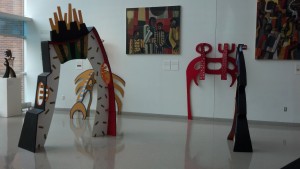
The large scale sculptures on view in the atrium of Tyler School of Art appear to be walking or moving, extending across the floor or bounding off the wall. At times referred to as “leaners” for the ways in which they interact with the gallery walls, these pieces appear to exist somewhere between painting and free-standing sculpture. Several beautiful examples of these works are on display both at Tyler and LaSalle.
Searles began exploring the possibilities for painted wood sculpture in 1978 when he moved from Philadelphia to New York. In “Freedom’s Gate II,” 1990, we see the artist bending and arching wood in ways that may suggest parts of a human figure. The black and yellow spikes on the top of this sculpture are a repeating motif in Searles’ work, a reference to the braided hairstyles worn by his daughters. We can see these same braids on the head of a young girl in “In Front of the Store,” 1971, a painting also on view at Tyler.
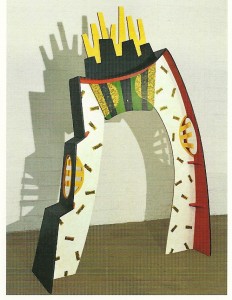
One of the strongest elements of these three exhibitions is the focus given to Searles’ evolution as an artist. The three shows form a complete survey of Searles remarkable career, and visiting all three venues allows us to get to know Searles deeply. As Maite Barragan notes, the exhibitions let us “come out with a great understanding of what Searles loved and how he worked.”
Tyler School of Art, Temple University — Charles Searles: In Motion, on view through June 16
LaSalle University Art Museum – Charles Searles: The Mask of Abstraction, on view through May 31
Woodmere Art Museum — Charles Searles: A Focus on the Figure, on view through June 15


